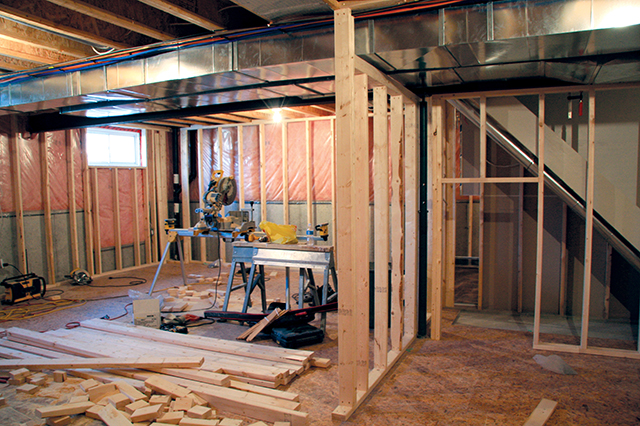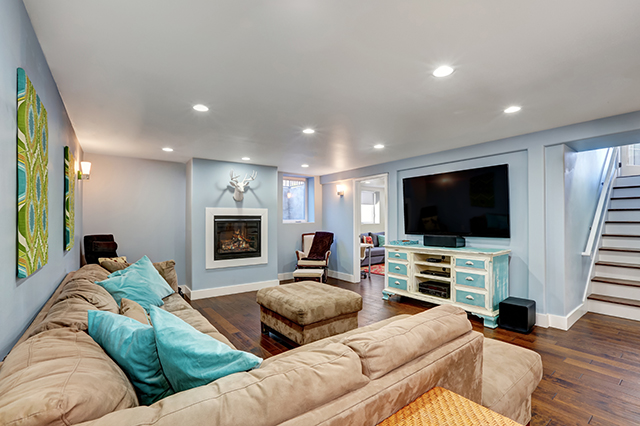If you’re thinking of working toward a finished basement, there are plenty of ways to make this oft-neglected space your favorite spot in the house. As long as you keep in mind the unique challenges of this kind of space and plan accordingly, basement remodeling can be a surprisingly rewarding experience. We’ll go over some of the major elements of working towards a finished basement that you can use for your own remodeling project.
Preliminary planning steps for basement renovations
One of the first things you want to do before any major changes in your basement is address any water issues. One obvious clue is if water is starting to seep through cracks in your wall. Once you’ve done any necessary repairs, and before you start building, you’ll likely need to check with your local town to see if a permit is required for basement renovations.
Building codes generally require that basements be a certain height and that windows are available for an emergency exit, so you’ll need to get confirmation that your basement can actually function as a living area. As you long as you have approval, you can begin your basement finishing yourself or hire a professional to insulate and build new walls.
How to mitigate flood risk
An unfortunate fact of life is that at some point, your basement will probably flood. This is why you need to have proper precautions in place to factor in this risk. For instance, a tile floor is usually a good water-resistant choice, and you’ll want to install a floor drain that will empty out any excess water. It may require extra money, but it will definitely help protect your basement from water damage. Be sure to sign up for AAA Homeowner’s Insurance in case you encounter any potential flooding or other issues in your basement.
How to add lighting to your finished basement
One major issue homeowners often find with basements is the short supply of natural light. However, since some building codes require there to be a second exit in a finished basement, you might as well take advantage of this requirement and add a large egress window. Some natural light will definitely transform your basement and make it more welcoming, especially if someone is going to live down there.
Of course, you’ll want to follow the tenets of good lighting design to make your space look comforting and accessible. The light that displays upward along the wall generally looks better than light that shines downwards, for the simple reason that it will make your space look taller and more spacious. Wall sconces add a nice elegant and traditional touch to most finished basements.

Designing tour finished basement
One way to craft your finished basement into a coherent and organized space is to separate it into zones for different activities. The large beams in most basements actually act as a good marker to designate areas for play, rest, watching TV, or whatever else you choose.
Basements make some of the best game rooms and home theaters for a number of reasons. They’re usually darker, cozier and removed from the rest of the house, which allows a good opportunity to disappear into another world onscreen. But they’re also great areas to play pool or have a drink, so you can save money and set up your own little bar in the basement. You can soundproof the basement with special drywall as well, which makes for an even cozier experience.
How to make your finished basement look good
One of the simplest ways to make your basement room look more appealing and natural is to have a dropped ceiling hide any unsightly pipes or ducts. This is a convenient and aesthetically pleasing way of hiding these parts, and you can access them easily with removable tiles. And choose your furnishings wisely. If you don’t have a ton of room, your choice of chair or table can make or break the space, so make sure it vibes well with the rest of the room’s style.
How to make your finished basement feel welcoming
Generally, you’ll want to choose furniture that’s a bit more welcoming and comfortable. Hard wooden chairs aren’t your best bet; instead, choose some nice, comfy lounge seats. Basements tend to be cold, so for the winter be sure to employ an in-floor radiant-heating system that will spread warmth evenly across the room, or install baseboard heating along the walls. Some nice fluffy rugs can also help to warm the space a bit.
Whether you’re looking to install a new bedroom or a theater room, your finished basement can offer a great opportunity to utilize extra space.
Any tips you’d recommend to someone interested in basement remodeling? Don’t hesitate to share in the comments below!














